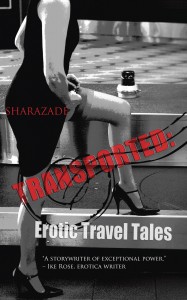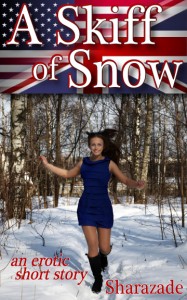Like a Veil (Circlet Press, 2010) is a collection of stories by four different authors tied together by a fanciful “Arabian Nights” theme. As editor Michelle Labbé explains in the introduction,
Shahrazad and her tales have inspired other storytellers from the beginning. The earliest surviving manuscript dates from the fourteenth century, and comprises only about three hundred nights of stories. Since that time, legions of anonymous writers have appended their own tales onto that number, each making their own contributions to fill the framework with the thousand and one nights promised.
It’s no surprise that the idea of a collection like this would appeal to me, given my writing name (which I have discussed previously here). I travel a bit in the Middle East, and have read both modern traveler’s accounts and traditional tales (think djinnis/genies, desert travelers, plot twists, lessons learned).
* * *
Her Way, by Anya Levin, about a group of archaeologists searching for a mysterious lost city, says this about the desert:
Stories discounted as mythical or euphemistic in countless ancient storybooks become eerily reasonable to a mind subjected to the open sprawl of the desert and the baking heat of the sun high above.
That could be a clever bit of foreshadowing, but I have to say, it is entirely true. You do feel different in the vastness of a desert. It’s so still and endless. Things you wouldn’t believe at home in your living room seem quite plausible on those immense dunes that feel like water under your feet. While reading her story, I remembered landscapes like the one below, and how I felt there (that’s the edge of the Sahara—yeah, just the edge!):
When you walk in sand like that, you can sink in up to your ankles; but turn around, and all but the last few footprints have already been erased by the wind. No problem understanding how sand like that could bury a city.
The travelers come upon a tent in the desert, which houses a sort of gatekeeper to the city. As is the way in such tales, she poses questions to the travelers about their intentions and purposes. A satisfactory answer wins admission to the city. But it isn’t just a question of guessing what the gatekeeper wants to hear—as is also the way in such tales, she can see through subterfuge.
“What do you want me to do?” I asked.
The woman raised a brow and asked, “What do you want to do?”
The question set off the arousal that had been smoldering, the simple words leaving my body and mind in a blaze fit to immolate. “And what if what I want isn’t polite, or nice, or…”
“All the better, then,” the woman said composedly. “For in the city,” and here she gestured behind her with one long, sleek arm, “while being polite is a good policy, honesty is valued above even that social nicety.”
What her honesty reveals about herself leads to the erotic elements of the story, so I know you wouldn’t want me to reveal that here. 😉
* * *
Blue-Eyed Djinn, by Angela Goldsberry, begins like this:
The sun was sinking low over the Arabian desert when the old man arrived at the walled city.
“Please,” he begged the guard at the gate, “night is almost upon us. I am but a poor old peddler with a half-dead camel. I have no defense against bandits and wild dogs. Please grant me admittance for the night.”
Oh, perfect! I love stories like that. Mysterious Arabian walled cities, like, oh, this one:
Of course, the old traveler gets to meet the Sultan, and offer him a gift—an intriguing little glass bottle with a guess what inside.
The Sultan laughed heartily. “A blue-eyed Djinn! Now I have heard everything! And what, pray tell, will this djinn grant me? Power? Riches? Women? I have all of these! What can he give me that I do not already have?”
“She, my Lord! She will give you a night — just one, but a night filled with such pleasure that I cannot begin to describe it!”
The genie performs exactly as promised, and yet not in a way that you’d expect.
One thing I particularly appreciated about this story was a light sprinkling of cultural elements — an article of clothing, a piece of fruit — that lent authenticity to the story. If you’ve never traveled to such places, those details wouldn’t hamper understanding in the least, and add a pleasing exoticness. But if you have, they add the perfect touch. [Note: It has always bugged me that “exoticity” is not the nominal form of “exotic.” Can this be changed?]
* * *
I will confess that I had to read the first part of Sunny Moraine’s Catch and Release (a title that cleverly works at several levels) twice to fully get it. Not because it was obscure or poorly written, not at all, but because it caught me by surprise.
The central hub of the ship is turning in its slow grav-spin and he sometimes thinks that he can feel it when he’s between decks like this, bouncing in the lower gravity with his hands on the ladder, so close to freefall he can taste it.
Wait, what? Is this science fiction? Well, yes. But it makes a perfect third story to a collection of four, with a different spin on the setting that still fits in very well. Space is a kind of desert too, isn’t it? And what the protagonist finds there takes him back in a way to the more traditional setting:
She is Baghdad, he thinks fitfully. They are one and the same, new, ancient, enticing, hungry. Baghdad rebuilt, center of the new world, rich with the wealth of the global economy, swelling with all the nations, reaching out to take him in. Trying to hold on. Which is why he had run, and now he is caught again. She is Baghdad, gleaming and seductive; she is the stars over him and the hot roof beneath, she is the lights and the noise and she is touching him, and this time he doesn’t pull away.
Can’t say I have any photos in my personal collection that are appropriate for it, though!
* * *
The Eater of Stories by Sophia Deri-Bowen took me back to a familiar place: dusty at-the-edge-of-the-desert towns, where storytellers visit (or, as in this tale, story gatherers):
He came when we were young. The caravans come through often where we are. Ela is no backwater, though it is neither so grand as the big oases. Still, it’s not so rare, even these days when we are diminished.
He wasn’t strange, until you looked again. His robes were then a little too white, and you realized that the jewels on his fingers sparkled when they shouldn’t. They would have gleamed in a sealed box, buried in the sands and forgotten.
This story was more melancholy, though it wasn’t ultimately sad, and I was touched by the power and importance of stories, stories told and stories heard. A fitting final story to the collection.
I suppose it might seem a little odd to review a collection of erotic stories and not (so far) say much about the naughty bits. It’s not that they weren’t there, or that they weren’t wonderful, it’s just that the other parts of the stories were so compelling. The other main element that ties these four stories together is lovely language. I know that’s a highly subjective statement, but then this is a subjective review. Not too long ago on this blog we engaged in a discussion off in the comments to some post about word choice – should writers eschew the ten-cent words and less common choices? No, I don’t think so. A well-chosen word is such a pleasure. Each writer in this collection had a distinctive style, but they all used good words well. I liked the sentence variety, too, and the poetic flow. Not artificial or put-on, but just right given the story type. Sentences like this one, from Catch and Release: There is a story behind it. Of course there is, Suleiman thinks as he turns restlessly, as if dreaming, and she whispers in his ear with her hot lips, smooth and organic as blown glass.
I’ve done it again, I’ve skipped the sex! Unforgivable. The erotic elements were very well done. Explicit without being crude, detailed without being mechanical. Passionate and loving. Between opposite-sex couples and same-sex couples. Between two humans, and between one human and one “other.”
It wouldn’t be a Shar review without some mention of a quirky detail, so here’s that part. One hesitation I have with e-books is the look. I don’t want to read something that looks like someone’s forwarded Microsoft Word document. This e-book looked lovely. I loved the fonts! Papyrus for the titles (how appropriate), and Hoefler Text (a somewhat old-fashioned-looking serif font) for the stories. I would have preferred ragged right margins, but that’s getting a bit picky, even for me. You could tell that this book was put together by people who cared about it, from the selection and sequencing of the stories to how they looked on the page.
All in all, it was a wonderful collection. Got me all nostalgic and warmed up, in more ways than one.
Like a Veil can be ordered from Circlet Press here, for $3.99 (if for some reason you prefer to buy it elsewhere, at the same price, there are links there to a number of other places such as Smashwords, Scribd, the Kindle Store, Barnes & Noble, etc.). A buck a story, people, and it zaps over immediately to your inbox. You’re not going to do better than that!
* * * * *











